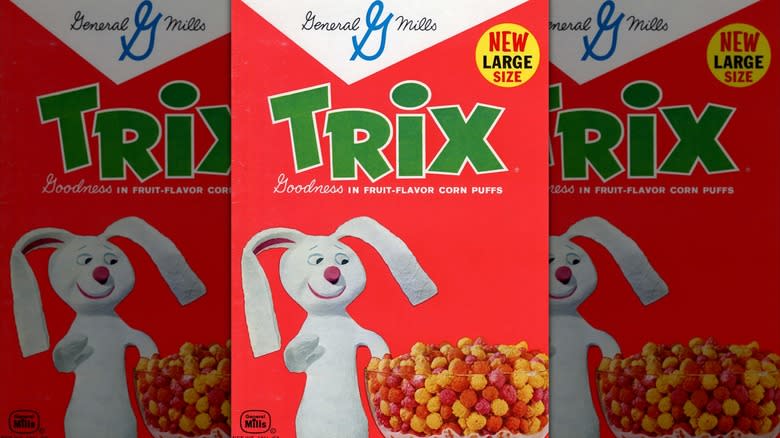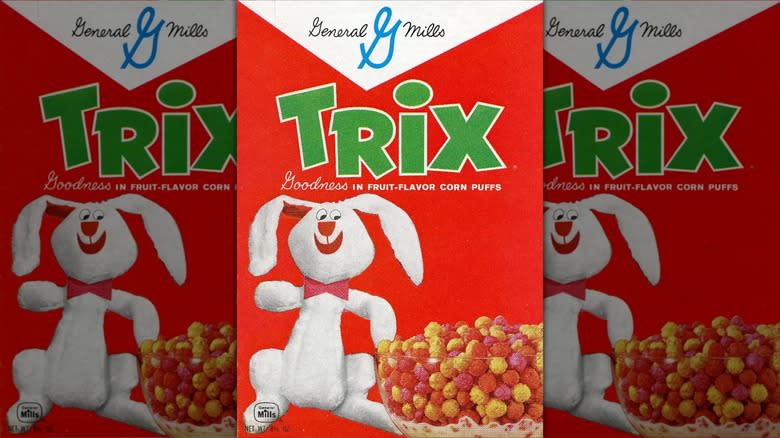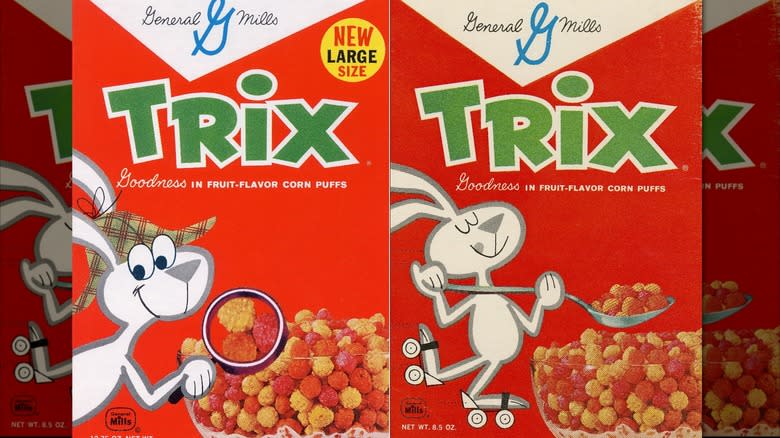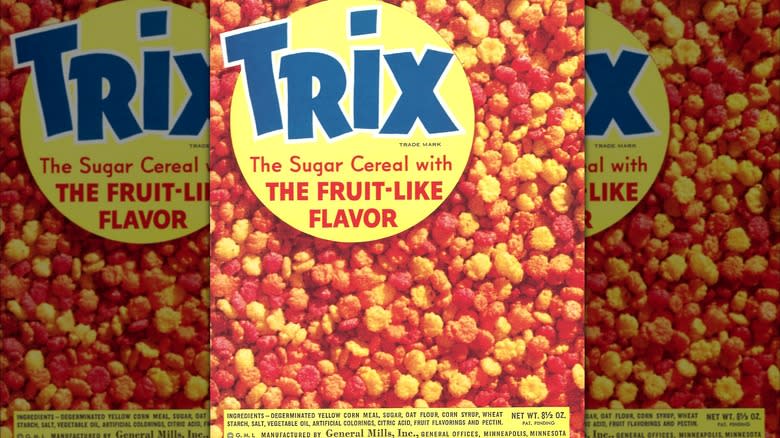Early Trix Boxes Featured An Uncanny Mascot

Few breakfast cereals evoke the same level of nostalgia and whimsy as Trix. This ever-changing, multicolored staple of childhood mornings boasts a fascinating history intertwined with the advancement of advertising. Its spokesanimal, the Trix Rabbit, is among the most iconic food mascots of all time — and is much older than you may think. Mashed spoke with General Mills, the parent company of Trix, Cheerios, Lucky Charms, and Cookie Crisp, to get the scoop (or spoonful) on Trix and its hapless, flopped-eared representative.
The hungry hare looked, well... different back in the day. The Trix Rabbit was more of an uncanny creature than a comical, cuddly bunny — humanoid eyes, long ears, toeless paws, and all. Five years after the cereal's launch, the Trix Rabbit debuted in a 1959 TV spot with a script that included the signature catchphrase, "Trix are for kids!"
According to General Mills, the manufacturer introduced Trix to grocery store shelves in 1954. Following a mid-20th century trend towards sugary grub aimed at children, Trix, with its red, orange, and yellow fruit-flavored puffs, became a pantry essential in households across America, with plenty of thanks to the anthropomorphic mascot we know and love. Television commercials were crucial in promoting the sweet cereal to the target audience. However, it wasn't until the creation of the Trix Rabbit that the brand found its true identity. While the original Trix Rabbit's traits may be a bit bizarre, his white fur, pink nose, and puckish grin have endured.
Read more: The Most Unique Chip Flavors Ever To Grace Store Shelves
The Trix Rabbit Was Designed To Resonate With Kids

Why did General Mills choose a greedy rabbit to characterize Trix cereal? As the company told Mashed, the Trix Rabbit "embodies the joy of the brand and provides a new way for Trix to engage with consumers." Rabbits are symbols of abundance, intuition, swiftness, and luck — ironically, in the Trix Rabbit's case. Dreamt up by Joe Harris, an illustrator and advertising executive at Dancer Fitzgerald Sample, the Trix Rabbit was designed as a mischievous bandit, constantly scheming to get his hands on a bowl of the corn-based cereal. Trix's primary marketing strategy focused on its taste and visual appeal. Plus, the famous line, "Trix are for kids!" is still widely recognized today. Harris drew inspiration from popular animated cartoons, infusing the Trix Rabbit with a timeless charm that resonated with customers, especially youngsters.
Since its inception, the Trix Rabbit has undergone several iterations, each one reflecting the evolving landscape of animation. In the early 1960s, the Trix Rabbit made his first appearance as an animated cartoon, captivating viewers with his boundless enthusiasm for his favorite fare. The Trix Rabbit struck a chord with children, and they eagerly awaited his latest antics. The campaign ultimately turned him into a beloved celebrity who could effectively sell the product.
Trix Has Experienced Some Changes

Over the decades, the Trix Rabbit has starred in countless spots that demonstrate the character's unwavering hankering for the crispy puffs. Meanwhile, Trix has undergone various changes and adaptations to stay relevant in an ever-changing business. Yet, despite the brand's established acclaim, it has encountered its fair share of challenges.
One notable controversy occurred in 2016 when General Mills announced plans to replace artificial colors and flavors in Trix with natural alternatives in response to growing concerns about artificial additives in food products. This decision sparked a backlash from buyers who claimed the formula tweak markedly altered the taste and look of the breakfast cereal. (Sounds like the notorious flop that was New Coke.)
In 2017, General Mills announced that it would revert to using artificial colors and flavors due to difficulties in achieving the vibrancy associated with the brand. While the seemingly slight modification was met with disappointment, it also highlighted the complex interplay between preferences, culinary science and technology, and promotional strategies.
The Silly Rabbit Continues To Induce Nostalgia

Despite the ups and downs, Trix continues to hold a special place in the hearts of millions. With a rainbow of six flavors, including raspberry (red), orange, lemon (yellow), watermelon (green), wildberry (blue), and grape (purple), cereal fans can get their fix any time of day, whether doused in milk, as a crunchy snack, or in a dessert recipe.
The Trix Rabbit, with his persistent pursuit of a simple pleasure, captures the spirit of tenacity and determination in the face of adversity. Moreover, Trix's longstanding "Silly Rabbit" campaign is undeniably memorable. The use of energetic characters and snappy slogans to stir emotional connections remains a cornerstone of marketing practices, a legacy that can be traced back to the early days of modern advertising.
From his humble beginnings as a quirky, odd-looking protagonist on cereal boxes and in TV ads to superstar status, the Trix Rabbit reminds us of gratification and wonder. As long as there are dreams to chase and bowls of fruit-flavored cereal to devour, the Trix Rabbit prevails as an epitome of imagination, perseverance, and of course, silliness.
Read the original article on Mashed

